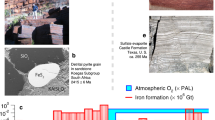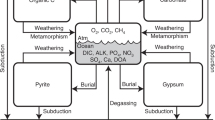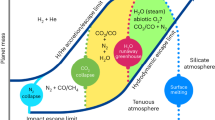Abstract
The history of the Earth has been characterized by a series of major transitions separated by long periods of relative stability1. The largest chemical transition was the ‘Great Oxidation’, approximately 2.4 billion years ago, when atmospheric oxygen concentrations rose from less than 10-5 of the present atmospheric level (PAL) to more than 0.01 PAL, and possibly2 to more than 0.1 PAL. This transition took place long after oxygenic photosynthesis is thought to have evolved3,4,5, but the causes of this delay and of the Great Oxidation itself remain uncertain6,7,8,9,10,11. Here we show that the origin of oxygenic photosynthesis gave rise to two simultaneously stable steady states for atmospheric oxygen. The existence of a low-oxygen (less than 10-5 PAL) steady state explains how a reducing atmosphere persisted for at least 300 million years after the onset of oxygenic photosynthesis. The Great Oxidation can be understood as a switch to the high-oxygen (more than 5 × 10-3 PAL) steady state. The bistability arises because ultraviolet shielding of the troposphere by ozone becomes effective once oxygen levels exceed 10-5 PAL, causing a nonlinear increase in the lifetime of atmospheric oxygen. Our results indicate that the existence of oxygenic photosynthesis is not a sufficient condition for either an oxygen-rich atmosphere or the presence of an ozone layer, which has implications for detecting life on other planets using atmospheric analysis12,13 and for the evolution of multicellular life.
This is a preview of subscription content, access via your institution
Access options
Subscribe to this journal
Receive 51 print issues and online access
$199.00 per year
only $3.90 per issue
Buy this article
- Purchase on Springer Link
- Instant access to full article PDF
Prices may be subject to local taxes which are calculated during checkout



Similar content being viewed by others
References
Lenton, T., Caldeira, K. & Szathmáry, E. in Earth Systems Analysis Sustainability (eds Schellnhuber, H., Crutzen, P., Clark, W., Claussen, M. & Held, H.) 29–52 (Dahlem Workshop Reports, Vol. 91, MIT Press, Cambridge, Massachusetts, 2004)
Holland, H. D. The oxygenation of the atmosphere and oceans. Phil. Trans. Soc. B 361, 903–916 (2006)
Brocks, J. J., Logan, G. A., Buick, R. & Summons, R. Archean molecular fossils and the early rise of eukaryotes. Science 285, 1033–1036 (1999)
Summons, R. E., Jahnke, L. L., Hope, J. M. & Logan, G. A. 2-Methylhopanoids as biomarkers for cyanobacterial oxygenic photosynthesis. Nature 400, 554–557 (1999)
Brocks, J. J., Buick, R., Summons, R. E. & Logan, G. A. A reconstruction of Archean biological diversity based on molecular fossils from the 2.78 to 2.45 billion-year-old Mount Bruce Supergroup, Hamersley Basin, Western Australia. Geochim. Cosmochim. Acta 67, 4321–4335 (2003)
Holland, H. D. Volcanic gases, black smokers, and the great oxidation event. Geochim. Cosmochim. Acta 66, 3811–3826 (2002)
Barley, M. E., Bekker, A. & Krapež, B. Late Archean to early Paleoproterozoic global tectonics, environmental change and the rise of atmospheric oxygen. Earth Planet. Sci. Lett. 238, 156–171 (2005)
Kump, L. R., Kasting, J. F. & Barley, M. E. Rise of atmospheric oxygen and the “upside-down” Archean mantle. Geochem. Geophys. Geosyst. 2, doi:10.1029/2000GC000114 (2001)
Kasting, J. F. The rise of atmospheric oxygen. Science 293, 819–820 (2001)
Catling, D., Zahnle, K. & McKay, C. Biogenic methane, hydrogen escape, and the irreversible oxidation of early Earth. Science 293, 839–843 (2001)
Catling, D. C. & Claire, M. W. How Earth's atmosphere evolved to an oxic state: a status report. Earth Planet. Sci. Lett. 237, 1–20 (2005)
Lovelock, J. A physical basis for life detection experiments. Nature 207, 568–570 (1965)
Hitchcock, D. & Lovelock, J. Life detection by atmospheric analysis. Icarus 7, 149–159 (1967)
Kasting, J. F., Liu, S. C. & Donahue, T. M. Oxygen levels in the prebiological atmosphere. J. Geophys. Res. 84, 3097–3107 (1979)
Farquhar, J., Bao, H. & Thiemens, M. Atmospheric influence of Earth's earliest sulfur cycle. Science 289, 757–758 (2000)
Pavlov, A. & Kasting, J. Mass-independent fractionation of sulfur isotopes in Archean sediments: strong evidence for an anoxic Archean atmosphere. Astrobiology 2, 27–41 (2002)
Bekker, A. et al. Dating the rise of atmospheric oxygen. Nature 427, 117–120 (2004)
Kopp, R. E., Kirschvink, J. L., Hilburn, I. A. & Nash, C. Z. The paleoproterozoic snowball Earth: A climate disaster triggered by the evolution of oxygenic photosynthesis. Proc. Natl Acad. Sci. USA 32, 11131–11136 (2005)
Li, Z.-X. A. & Lee, C.-T. A. The constancy of upper mantle fO2 through time inferred from V/Sc ratios in basalts. Earth Planet. Sci. Lett. 228, 483–493 (2004)
Pavlov, A., Brown, L. & Kasting, J. UV shielding of NH3 and O2 by organic hazes in the Archean atmosphere. J. Geophys. Res. 106, 23267–23287 (2001)
Pavlov, A., Hurtgen, M., Kasting, J. & Arthur, M. Methane-rich Proterozoic atmosphere? Geology 31, 87–90 (2003)
Kasting, J. & Donahue, T. The evolution of the atmospheric ozone. J. Geophys. Res. 85, 3255–3263 (1980)
Isley, A. E. & Abbott, D. H. Plume-related mafic volcanism and the deposition of banded iron formation. J. Geophys. Res. 104, 15461–15477 (1999)
Shields, G. & Veizer, J. Precambrian marine carbonate isotope database: version 1.1. Geochem. Geophys. Geosyst. 3, doi:10.1029/2001GC000266 (2002)
Pavlov, A. A., Kasting, J. F., Brown, L. L., Rages, K. A. & Freedman, R. Greenhouse warming by CH4 in the atmosphere of early Earth. J. Geophys. Res. 105, 11981–11990 (2000)
Kasting, J. F. Methane and climate during the precambrian era. Precambrian Res. 137, 119–129 (2005)
Kharecha, P., Kasting, J. F. & Siefert, J. L. A coupled atmosphere-ecosystem model of the early Archean Earth. Geobiology 3, 53–76 (2005)
Ren, T., Amaral, J. A. & Knowles, R. The response of methane consumption by pure cultures of methanotropic bacteria to oxygen. Can. J. Microbiol. 43, 925–928 (1997)
Holland, H. D. Discussion of the article by A. C. Lasaga and H. Ohmoto on “The oxygen geochemical cycle: dynamics and stability”, Geochim. Cosmochim. Acta 66, 361–381, 2002. Geochim. Cosmochim. Acta 67, 787–789 (2003)
Hayes, J. M. & Waldbauer, J. R. The carbon cycle and associated redox processed through time. Phil. Trans. R. Soc. B 361, 931–950 (2006)
Acknowledgements
C.G. is funded by the Natural Environment Research Council. T.M.L. is supported by a Leverhulme Prize. We thank J. Kasting and L. Kump for comments on the manuscript. C.G. thanks J. Meiss for teaching dynamical systems. Author Contributions T.M.L. and A.J.W suggested the study. C.G. wrote and analysed the model with supervision from T.M.L. and A.J.W., and led writing the paper.
Author information
Authors and Affiliations
Corresponding author
Ethics declarations
Competing interests
Reprints and permissions information is available at www.nature.com/reprints. The authors declare that they have no competing financial interests.
Supplementary information
Supplementary Notes
This file contains Supplementary Figures and Supplementary Discussion. This includes details on compilation of proxy data for palaeo-oxygen; full model derivation; and temperature difference calculations. (PDF 162 kb)
Rights and permissions
About this article
Cite this article
Goldblatt, C., Lenton, T. & Watson, A. Bistability of atmospheric oxygen and the Great Oxidation. Nature 443, 683–686 (2006). https://doi.org/10.1038/nature05169
Received:
Accepted:
Issue Date:
DOI: https://doi.org/10.1038/nature05169
This article is cited by
-
Reconciling discrepant minor sulfur isotope records of the Great Oxidation Event
Nature Communications (2023)
-
The development of deep-ocean anoxia in a comprehensive ocean phosphorus model
GEM - International Journal on Geomathematics (2023)
-
Mechanism of bacterial communities regulating litter decomposition under climate warming in temperate wetlands
Environmental Science and Pollution Research (2023)
-
Identification of nosZ-expressing microorganisms consuming trace N2O in microaerobic chemostat consortia dominated by an uncultured Burkholderiales
The ISME Journal (2022)
-
Oxidative metabolisms catalyzed Earth’s oxygenation
Nature Communications (2022)
Comments
By submitting a comment you agree to abide by our Terms and Community Guidelines. If you find something abusive or that does not comply with our terms or guidelines please flag it as inappropriate.



